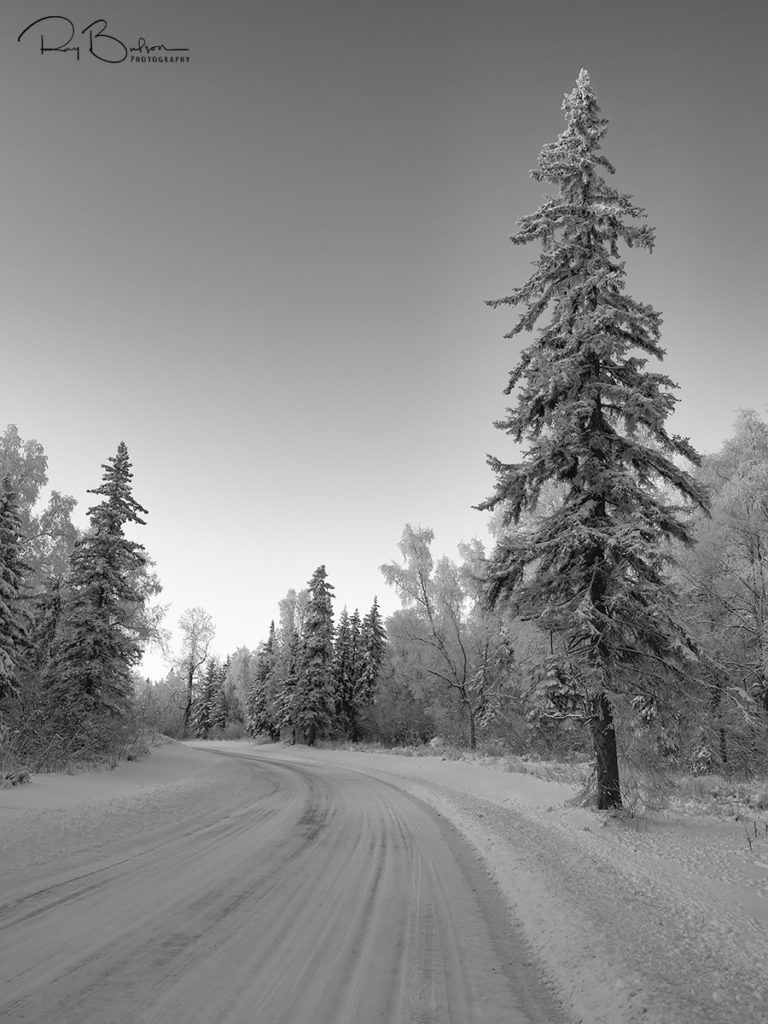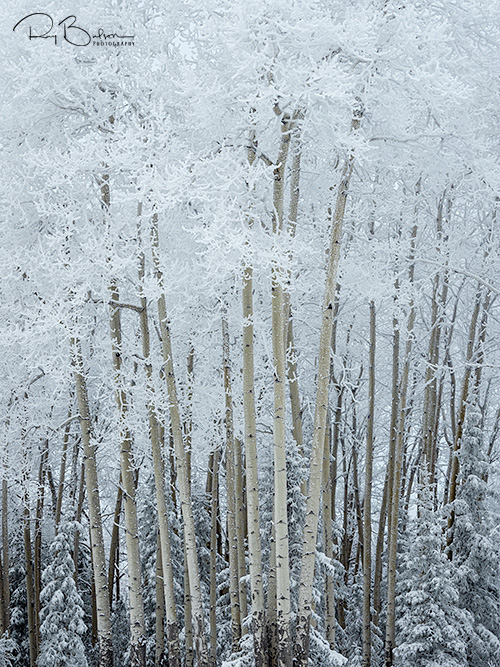
Olympus OM-D EM-1 Mark II, Olympus M. Zuiko 12-100 mm f/4.0
As I write this, Southcentral Alaska is in the midst of a January deep freeze reminiscent of winters past. Subzero temperatures combined with ground fog are adorning trees with thick layers of hoarfrost — the foliage of winter. While the Christmas trees in our homes may have been taken down, the outside residents of the boreal forest continue to decorate the landscape in myriad, fascinating ways. After spending the last several days photographing the same location in Eagle River Valley (working the subject matter, so to speak), I came away with a few photos and observations.
The Zen of Cold
Something about this white spruce caught my attention. It reminded me of a Dr. Seuss tree. On a more intellectual level, however, it just seemed like it stood alone among the rest; a stoic, silent sentinel. Being that it is a tall tree it is quite old and has a long history in this spot. On the left side its lower branches are broken off perhaps as a result of being too close to the road. It was -27° F when I took this photo as the sun was beginning to rise and illuminate the trees. I wondered if the tree felt cold or pain in such conditions—this is where the Zen of suffering comes in. Would it be crying out right now or rejoicing in the imminent warmth of the sun’s first rays as it touches the top branches? [Anyone who thinks I am trying to anthropomorphise trees should read The Hidden Life of Trees by Peter Wohlleben.] It is well established that the essential oils in spruce needles and bark act like antifreeze so the trees won’t freeze in cold weather. This explains their prevalence in sub-Arctic and Arctic regions.
In post-processing I converted the original color image to black and white to enhance the cold/stark mood of the scene. Commenters on my social media post of this image felt the tree was swaying toward the warming sun and rejoicing to be alive. Others hoped the extended cold would kill some of the spruce bark beetles that have been devastating boreal forests in the warming global climate. Graphically, I like the diverging lines of the road and the slight curve of the tree. Partly because of the wide angle lens (35mm focal length equivalent) and the vertical tilt of the camera, the trees appear to converge toward the light. While there are many trees in this composition there is a simplicity that works. Maybe this is what caught my eye initially.
The Zen of Cold Redux

Canon EOS 5DsR, Sigma 35 mm f/1.4 Art
This image of the same tree was taken on a different day and in the afternoon as opposed to the morning for the previous photo. The light was different. The low winter sun angle passing through the ground fog diffused the sun light and produced a warm glow on the trees. The cool blue sky contrasted with the warm yellow. Instead of a vertical (portrait) orientation, this composition was horizontal (landscape) to take in more of the surroundings. The result is a different impression of the tree. While a wider, horizontal composition would usually deemphasize the tree, I find that it still retains prominence as the primary subject. Indeed, because the tree top occupies the negative space of the sky, there is a smaller frame within the larger frame that draws our attention once again to the spruce tree. The line of the road and the converging surrounding trees all point to this spruce tree.
In my social media post of this image, I asked which rendition of the spruce tree do people prefer? Almost all preferred the vertical black and white. Overall, each one tells a different story, and that story can be unique to each person. Such is the power of photography.
The Embrace

Canon EOS 5DsR, Canon EF 70-200 mm f/2.8L IS II
Look closely and you will see the branches of a spruce tree wrapped around the trunk of another tree, either a birch or an aspen. Initially the trunk of the tree could be mistaken as belonging to the spruce tree. Technically it’s too light to be a trunk from an evergreen. The darker trunk of the spruce tree can be seen behind the lighter trunk in a couple places in the photo.
This intermingling of two trees raises so many questions. Did the trees grow at the same rate? Or did the hardwood grow quickly and force itself through the spruce? Is there some kind of cooperation going on here? For example, does either tree benefit from the presence of the other? In the aforementioned book on trees it is noted that “trees…are perfectly capable of distinguishing their own roots from the roots of other species and even from the roots of related trees.” So there is a contact of sorts between trees even ones that could be competitors — for water, as an example.
So why did I title this The Embrace? Because it could be the loving embrace of a parent with their child. Or the embrace of two friends who have been through a lot together. It could be the comforting embrace of one person consoling another. Or the embrace of lovers who intimately know the curves of each others bodies. A photographer friend of mine with a great sense of humor jokingly said the spruce is embracing the other tree to keep it warm in the cold! Maybe the best take away from this that is apropos to humanity is: life is hard and survival sometimes requires cooperation.
Winter Foliage
I’ll let the elegance of hoarfrost on trees speak for themselves.





Very interesting Ray. You have a keen way of describing pictures and the landscape Maybe a writer in your next venture. You are great at what you do. I’m proud of you..
Thank you, Linda!